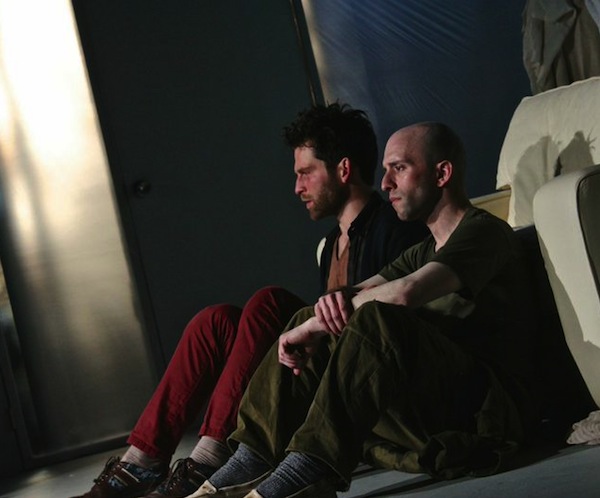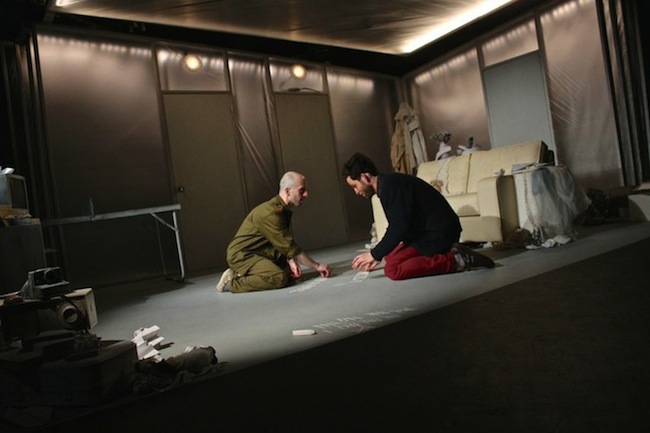Theater Review: “From the Deep” — Real Pain in an Imaginary Space
From The Deep suggests that Boston’s theater community would be better served if it put more of its resources into presenting the work of local literary talent.
From The Deep by Cassie M. Seinuk. Directed by Lindsay Eagle. Presented by Boston Public Works Theater Company at the Boston Center of the Arts, through March 28.

Ilan (Charles Linshaw) and Andrew (Jeff Marcus) in Boston Public Works Theater Company’s “From the Deep.” Photo: Marc J. Franklin.
By Ian Thal
The room is brightly lit, its contents are mostly white, beige, and ecru, cluttered with the personal effects of its former occupants. There is a sofa, a television stand, and a bookcase. Two young men, a small Israeli in military fatigues, Ilan (Charles Linshaw), and a tall, bearded American student in flannel, Andrew (Jeff Marcus), play ping-pong.
In From The Deep, playwright Cassie M. Seinuk quickly introduces the audience to the central conceit of her play: during his five years of captivity, Ilan has discovered that the room has rules. There are three locked doors: Two doors, one for each captive, will unlock at the unseen captors’ behest; a third threatens to swallow up either prisoner when there is no longer any hope. There are never more than two prisoners and time passes differently for each captive. In the two hours experienced by the audience, Ilan counts seventeen days in tally marks on the floor; in the same time only three days pass for Andrew.
Ilan has rules as well, activities that have kept him sane during his time as a prisoner of war. He draws maps, lists off Israel’s Olympic medals, reconstructs his family tree, hums both “Hatikvah” (“The Hope” – Israel’s national anthem) and the Champs’ 1958 hit “Tequila.” Keeping himself active, he insists that both he and his cellmate speak about themselves in the present tense, never in the past tense. In these ways he maintains hope and tries to draw Andrew out of his deepening despair.
This strange space — Ilan speculates that there are many such rooms — is a place of psychic refuge for those missing and held captive. Oddly, it can be shared by people far removed in geography and situation. His previous roommate, known only as “the girl,” was a captive of one of the waring factions in the on-going Somali Civil War. She wasn’t taken for ransom, but for the sexual exploitation of the soldiers. Ilan was unable to save her, and he appears to have as much regret over her fate as he does for the members of his own unit, who may have been killed when he was captured.
Gilad Shalit, Seinuk’s inspiration for Ilan, was a corporal in an armor unit abducted in a cross-border raid (via an underground tunnel from the Gaza Strip) by Palestinian militants on June 25, 2006. This attack, along with rocket fire, set off the first armed conflict between Israel and Gaza since the former had disengaged from Gaza the year before. The Operation Summer Rains rescue attempt to free Shalit failed; meanwhile, it was overshadowed by the more extensive war in southern Lebanon between Israel and Hezbollah.
During his five years of captivity Shalit became a cause célèbre both in Israel and in the Jewish diaspora. Rallies for his release were common; his supporters often used his portrait as a profile picture on social media. Every nuance of the stalled negotiations dedicated to his liberation (unlike many countries, Israel does negotiate with terrorists) made international news. Shalit’s October 18, 2011 release was brought about when Israel set free 1,027 Palestinian and Arab Israeli prisoners. (Ironically, Hamas had rejected a similar offer in 2009.) 280 of those prisoners had been serving life sentences for their involvement in terrorist attacks – making this prisoner swap a very bitter pill for some – especially because many of the released prisoners returned to terrorist activity soon after.
Ilan’s backstory hews closely to Shalit’s biography (the only major difference appears to be that the year of his capture here is 2009). Andrew’s relationship to his real life inspiration is much more speculative. In October 2012, the body of Jonathan Dailey, a 23 year-old North Carolina native and graduate student at Boston Architectural College was found at the bottom of the Charles River. The corpse was bound in chains and weighed down by a cinder block. Dailey had been missing for a week (the mystery of his disappearance remains unsolved).
Andrew, by contrast, is from a Christian fundamentalist family in a rural Pennsylvanian town where adults will physically beat adolescent males that they suspect are gay. Despite his attraction to Boston’s cosmopolitan sensibility, Andrew remains deeply closeted. Ironically, the character’s first tentative effort to come out – going to a gay bar where nobody knows his name – brings him to the notice of his soon-to-be captor.
Seinuk acknowledges but does not dwell on the political context of Ilan’s imprisonment; he is largely in the dark regarding the diplomatic machinations outside beyond his cell. The economics of abduction are often expensive: the captors need to keep the captive alive, guard against escape, and discourage rescue attempts by keeping the location secret. Captors must also be aware of the market price of their captives. Ilan’s keepers may not value their prisoner as a human being, but they know that his government values him highly. Less is known about Andrew’s keeper and his concern for the man’s value. The captor’s means of torture is simulated drowning, dunking Andrew’s head in a bucket.
Seinuk has given herself several daunting challenges in From the Deep. Her protagonists have little control over their fates — they ultimately play out off stage. So the action is necessarily reactive in nature; her characters must prepare their increasingly fragile bodies to withstand what is happening to them outside the room. In that sense, nothing much is at stake in the room or in the rule-structured games that Ilan cajoles Andrew into playing. Yet, the relationship becomes compelling because of the psychological revelations that the unrealistic setting draws out of these figures.

Ilan (Charles Linshaw) and Andrew (Jeff Marcus) in Boston Public Works Theater Company’s “From the Deep.” Photo: Marc J. Franklin.
The room in From The Deep is not an allegorical cage, like the hotel room in Sartre’s misanthropic play No Exit. Ilan and Andrew are still alive and connected with their bodies and their captors. How can it be that, separated by continents, two men dealing with the trauma of captivity and torture find each other in the same realm of imaginary refuge? Perhaps one man is the imaginary construct of the other, but which one is the dream? Andrew knows about the rallies for Ilan’s release, occasionally read about him on the news, where he saw his face: who better to coach Andrew through his ordeal than a fantasy version of an IDF soldier who has endured five years of captivity? Meanwhile, besides compiling lists, playing games, and humming to keep himself calm, might not conjuring up an American student help Ilan get over his survivor’s guilt for his fallen comrades or the Somalian girl he could not save? Perhaps From the Deep should be seen as a postmodern play: it posits two contradictory but equally “real” realities. Still, the performance ends with the stage left empty for a few seconds. The audience remains. The now vacant set perhaps inviting the watchers to experience a moment of catharsis?
Director Lindsay Eagle has assembled a strong team for this production, and they are up to serving the dramatic demands of the script. As Ilan’s time passes Chris Bocchiaro’s lighting design cycles from the sterile white light of the room to the warmer colors of dusk and dawn. Mike Stanton’s sound design, structured mostly around two clocks ticking at different tempos, concretizes the pair’s different perceptions of time. Megan Kinneen’s set is similarly imaginative: several layers of translucent plastic membranes are stretched taut over the frames of two walls and a hanging ceiling. They are just flexible enough to ripple like the surface of the Charles River, poetic contract to the abandoned clutter in the room. Rose Fieschko’s fight choreography flows naturally from the action.
Charles Linshaw makes for an energetic Ilan. The actor bounces about, his constant activity serving as both exercise and distraction, yet he stops now and then to let the underlying despair show through the cracks of the figure’s playful disposition. Linshaw’s skills as a dialect coach are in evidence: he supplies an excellent Israeli accent, one that identifies Ilan as someone who has largely mastered the subtleties of English grammar without leaving home. Jeff Marcus’s Andrew registers the fear and resignation of someone who believes he will soon be cruelly murdered. Still, flickers of hope remain — at times, Andrew gratefully succumbs to Ilan’s attempts to play, to imagine that he just might live.
From The Deep, is presented by Boston Public Works, a collective of seven Boston area playwrights. Several months ago, in an interview with four BPW playwrights, Seinuk showed herself to be an articulate spokesperson of the necessity for playwrights, especially in our area, to take up the challenges of self-production. From The Deep is further proof that Boston’s theater community would be better served if it put as much of its resources into presenting the work of local literary talent as does in the habitual importation of the (often) mediocre work stuffed into the New York-centric new play pipeline.
Ian Thal is a playwright, performer and theater educator specializing in mime, commedia dell’arte, and puppetry, and has been known to act on Boston area stages from time to time, sometimes with Teatro delle Maschere. Two of his short plays appeared in theater festivals this past summer. He has performed his one-man show, Arlecchino Am Ravenous, in numerous venues in Massachusetts and Rhode Island. One of his as-of-yet unproduced full-length plays was picketed by a Hamas supporter during a staged reading. He is looking for a home for his latest play, The Conversos of Venice, which is a thematic deconstruction of Shakespeare’s The Merchant of Venice. Formerly the community editor at The Jewish Advocate, he blogs irregularly at the unimaginatively entitled From The Journals of Ian Thal, and writes the “Nothing But Trouble” column for The Clyde Fitch Report.
Tagged: Boston Public Works, Boston Public Works Theater Company, Cassie M. Seinuk
